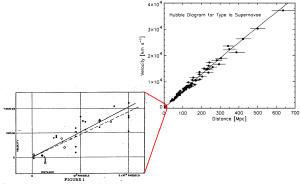Post
How Far We’ve Come
10 October 2013
 Right: Robert P. Kirshner, Left: Edwin Hubble
Right: Robert P. Kirshner, Left: Edwin HubbleOften in astronomy and astrophysics we talk about the big breakthroughs. Galileo’s discovery of the moons of Jupiter that showed not everything moves about the Sun, Henrietta Leavitt’s discovery of the cepheid luminosity relation which allowed us to measure the distance to galaxies, Eddington’s observation of light deflection that verified Einstein’s theory of general relativity. But much of the field is based upon lesser findings.
Simply taking good observations and building a database of observations can be extremely useful. The countless astronomers (amateur and professional) that take measurements night after night. The large scale sky surveys that require large teams to coordinate. The computational analysis and data mining necessary to discover interesting relations that may indicate some interesting physical process.
We remember the big discoveries, but we often don’t realize how later observations help to reinforce or overthrow these discoveries. As an example, consider Hubble’s discovery of the expansion of the universe. Edwin Hubble is most famous for his discovery that the universe is expanding, which he did by demonstrating a linear relation between the distance of a galaxy and its redshift due to recession, a relation now known as Hubble’s law.
Hubble was able to demonstrate this relation because Henrietta Leavitt had studied more than 1,700 Cepheid variable stars, measuring their periods of brightness variation to discover the period luminosity relation. Through this relation, Hubble could measure the periods of Cepheid variables in nearby galaxies to determine their distances. Hubble did not measure the redshifts of these galaxies themselves, but relied on observations made by Vesto Slipher and Milton Humason. Combining these observations Hubble was able to show the relation seen in the lower left figure above (taken from Hubble’s 1929 paper on the subject).
While Hubble is given credit for the initial discovery of the distance-redshift relation, later astronomers continued to take measurements of the distances of galaxies and their redshifts. Some of these observations were made as a direct study of Hubble’s Law, while others were part of other research efforts. But over the next 70 years measurements got better and the range of galactic distances got larger. You can see this in the upper right of the figure above, which plots a more modern graph of the relation. Hubble’s original data spans the small red square in the lower left corner of the figure. In 70 years we were able to expand Hubble’s discovery by a factor of 350.
Then in 1998, Purlmutter, Schmidt, and Riess used observations of very distant galaxies to show that the universe was not just expanding, but accelerating. They could show that this was not just a corrected fit of Hubble’s law in part due to the observations made during the 70 years between their observations and Hubble’s. These three were awarded the Nobel prize in 2011 for their discovery of cosmic expansion. A discovery that was built upon a history of careful observations made over decades.
We’ve come a long way in our understanding of the universe.